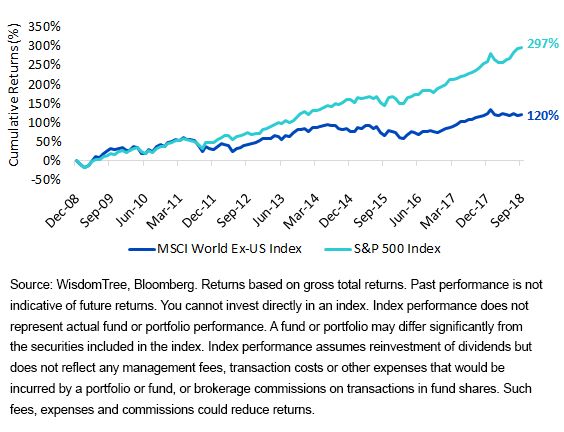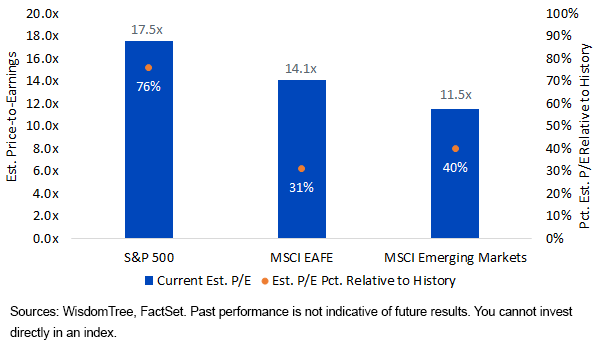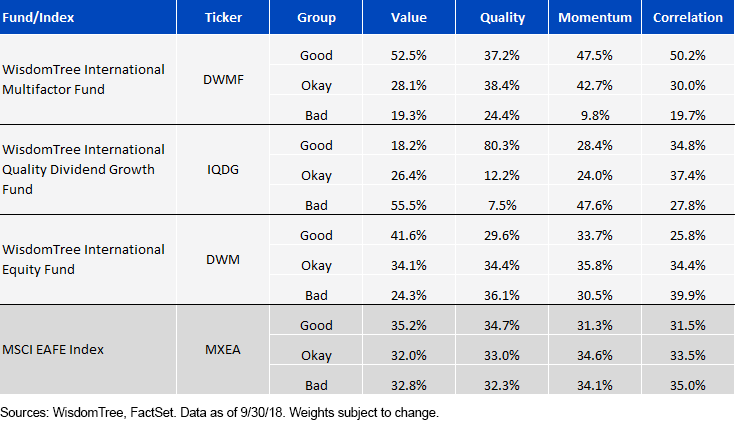Don't Sleep on Developed International Equities


So far in 2018, the performance of global equities has caught a lot of investors off guard. 2017 was a year of robust and synchronized global growth that led broad developed international indexes to outperform the U.S., measured in U.S. dollars.1 This year, the script has violently flipped, with the U.S. outperforming. This reversal has led global fund managers to take their biggest over-weight in the U.S. since the start of 2015.2
Investors tend to overly consider recent experiences and extrapolate them into the future, and fund flows provide some clear insight into this. It is challenging to know what the next shift in the market will be, but we do think there is a sound case for maintaining, or adding, a healthy allocation to developed international equities in a strategic portfolio today.
In addition to the well-established diversification benefits espoused by modern portfolio theory, an investment case today is centered on attractive valuations and accommodative monetary policy.
A Decade of U.S. Outperformance
There is no shortage of fears keeping investors on the sidelines when it comes to developed international equity exposure. Trade war rhetoric, a looming Brexit deadline, an Italian budget crisis and a stronger dollar environment each have weighed on investor sentiment. These factors have contributed to U.S. equities widening their post-’08 crisis outperformance gap this year. Since the end of 2008, the S&P 500 has outperformed the MSCI World ex USA Index by almost 180%. International diversification over this period has been tough to stomach for U.S.-based investors.
MSCI World ex USA Index vs. S&P 500
(12/31/08–9/30/18)

In our view, outperformance of the U.S. versus developed international equities is often cyclical, with waves of outperformance often lasting around a decade and sometimes more. With the 2008 to 2018 decade dominated by U.S. performance, mean reversion seems likely at some point, and international equities may provide an outlet for taking some chips off the table after a nearly 300% rise in U.S. markets.
The Valuation Advantage
With many of the aforementioned risks well established and priced into valuations, developed international equities trade at attractive valuations relative to both the U.S. and its own historical levels. The MSCI EAFE Index’s current forward price-to-earnings (P/E) ratio is priced in the 31st percentile of its long-run levels. That means that the index has been more expensive than it is today, currently at 14.1x, almost 70% of the time over the past 16 years.
The S&P 500 Index, on the other hand, which trades at a roughly 25% premium to developed international equities, is inside of its top quartile of expensiveness—and these are at cheaper valuations than were seen before the 20%+ earnings growth of 2018. Today’s valuations suggest valuation expansion is likely to be a more significant tailwind for MSCI EAFE returns than the S&P 500 going forward.
Current Global Valuations Relative to Historical
(1/1/02–9/30/18)

For definitions of the terms in this chart, please visit our glossary.
This valuation differential is further enhanced by looking at the relative opportunities compared with traditional fixed income instruments. The U.S. Federal Reserve has raised its short-term policy rate in increments of 25 basis points eight times over the past three years, with a ninth hike anticipated for this December that will put the upper end of its target at 2.50%. Compare this with short-term rates in the eurozone and Japan that are still negative and thus offer a higher risk premium for equity investors in those markets than in the U.S.
How to Allocate Today: Factors to Consider
WisdomTree offers a comprehensive suite of funds that provide exposure to international equities. In the table below, we highlight three differentiated exposures that we believe offer vehicles for investors with a variety of objectives. The Good, Okay and Bad categories for each factor are based on the multifactor scores used for the WisdomTree International Multifactor Fund. By design, each category contains roughly a third of the total market cap of the MSCI EAFE Index. Tilts away from the market across these categories indicate how our Funds tap into these different factors. A higher weight in the Good category indicates more of the fund’s weight in stocks scoring highly on that factor.
Factor Quilt

- WisdomTree International Multifactor Fund (DWMF): DWMF takes deliberate active risks relative to the market in pursuit of outperformance through a unique blend of fundamental and technical factors. The chart above shows that the fund is over-weight the market across the board in the Good category for each factor and under-weight in the Bad category. In addition to these equity factors, this Fund also takes currency risk management as one of the multiple factors being actively managed. As of this writing, the Fund’s aggregate hedge ratio was about 77%,3 providing material risk reduction benefits in this strong dollar environment.
- WisdomTree International Quality Dividend Growth Fund (IQDG): The Index that IQDG tracks utilizes an annual screen on fundamental metrics including dividend payout ratios, return on equity (ROE), return on assets (ROA) and long-term estimated earnings growth in selecting 300 dividend-paying companies. These metrics were chosen with the aim of constructing a unique rules-based process that targets quality dividend-paying companies with high ability to grow their dividends over time. The most notable factor tilts are the 80% weight in the Good category on Quality and 18% in Good Value. IQDG trades at a forward P/E of 17.3x versus 14.1x for MSCI EAFE, which is a reasonable 22% premium given the significant ROE improvement of 24.6% versus just 11.4% for MSCI EAFE.4
- WisdomTree International Equity Fund (DWM): DWM was one of the first Funds launched by WisdomTree in 2006 as part of our international dividend-weighted suite. This Fund takes modest tilts on the market by screening for dividend payers and weighting by dividends but provides a disciplined fundamental rebalance to help reduce valuation risks and increase dividend yields on the broad market. From a factor perspective, this valuation-sensitive approach can be seen from the higher value-tilt at about 42% of its weight in Good Value.
Conclusion
After significant relative outperformance in one market like we have seen over the past decade, some investors begin to question the merits of maintaining their diversification. But this outperformance and the valuation advantage that now exists in developed international equities helps bolster the argument for exactly why now may be the time to maintain, or even add to, a global portfolio. WisdomTree offers a variety of ways to tap into this market, including our Funds discussed above, for investors to utilize, depending on their goals and views on currency risk management.
1Source: Bloomberg. Returns for developed international equities measured by the MSCI EAFE Index and, for U.S. equities, the S&P 500 Index.
2Source: “Global Fund Manager Survey: Splendid Isolation,” Bank of America Merrill Lynch, 9/18/18.
3Source: WisdomTree. Data as of 10/4/18.
Important Risks Related to this Article
There are risks associated with investing, including possible loss of principal. Funds focusing on a single country, sector and/or funds that emphasize investments in smaller companies may experience greater price volatility. Investments in non-U.S. securities involve political, regulatory, and economic risks that may not be present in U.S. securities. For example, foreign securities may be subject to risk of loss due to foreign currency fluctuations, political or economic instability, or geographic events that adversely impact issuers of foreign securities. Please read each Fund’s prospectus for specific details regarding each Fund’s risk profile.
Diversification does not eliminate the risk of experiencing investment losses. Dividends are not guaranteed, and a company currently paying dividends may cease paying dividends at any time.


